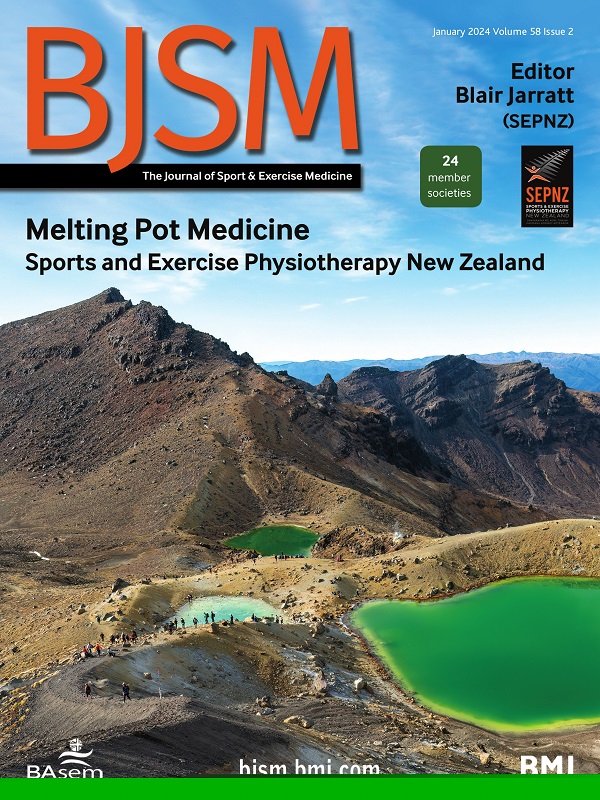运动崩溃与镰状细胞特征相关:从共识到困惑
IF 11.6
1区 医学
Q1 SPORT SCIENCES
引用次数: 0
摘要
镰状细胞特征(SCT)及其与战士和运动员(WA)的劳损性横纹肌溶解(ER)和运动相关死亡(ERD)的关系是运动医学界和美国国防部(DoD)面临的重要而有争议的问题。虽然SCT携带者的状态在很大程度上被认为是良性的,但潜在的风险,特别是高强度的重复或连续运动,越来越多地被认识到。2010年两名士兵的死亡促使健康和军事表现联合会在马里兰州贝塞斯达的军警服务大学召开首脑会议1 .与美国运动医学学院合作,感兴趣的国防部实体、美国运动医学医学会、美国血液学学会以及血液学和运动医学界的选定成员开会讨论SCT,特别强调减轻西澳的风险。在那次峰会上,“与镰状细胞特征相关的运动崩溃”(ECAST)一词被采用,认识到在没有明确认识的病理生理学的情况下,WA中ER和ERD的相对风险增加。随后,2019年在军事人员中发生的一系列ECAST事件促使对目前的努力进行了重新评估,并呼吁召开第二次共识会议。这次会议的结果是,美国陆军采用了一项政策,对SCT进行筛选和教育,以与所有其他国防部服务保持一致。协商一致的管理战略包括确定挣扎的作战人员或运动员,并进行紧急医疗评估,包括提供氧气、提供自动体外除颤器……本文章由计算机程序翻译,如有差异,请以英文原文为准。
Exercise collapse associated with sickle cell trait: from consensus to confusion
Sickle cell trait (SCT) and its association with exertional rhabdomyolysis (ER) and exercise-related death (ERD) in warfighters and athletes (WA) are significant and controversial issues confronting sports medicine communities and the US Department of Defense (DoD). Although SCT carrier status is largely considered a benign condition, potential risks, in particular with intense repetitive or continuous exertion, are increasingly recognised. The deaths of two soldiers in 2010 prompted the convening of a summit by the Consortium for Health and Military Performance at the Uniformed Services University in Bethesda, Maryland.1 In collaboration with the American College of Sports Medicine, interested DoD entities, the American Medical Society for Sports Medicine, the American Society of Hematology and selected members of the haematology and sports medicine community met to discuss SCT with particular emphasis on mitigating risk in WA. During that summit, the term ‘exercise collapse associated with sickle cell trait’ (ECAST) was adopted, recognising the increased relative risk of both ER and ERD in WA, in the absence of a clearly recognised pathophysiology. A subsequent series of ECAST events in military personnel in 2019 prompted a reevaluation of current efforts and called for a second consensus conference. As a result of that conference, the US Army adopted a policy for SCT screening and education to align with all other DoD services. Consensus management strategies included identification of the struggling warfighter or athlete, with urgent medical assessment to include the provision of oxygen, the availability of an automated external defibrillator …
求助全文
通过发布文献求助,成功后即可免费获取论文全文。
去求助
来源期刊
CiteScore
27.10
自引率
4.90%
发文量
217
审稿时长
3-8 weeks
期刊介绍:
The British Journal of Sports Medicine (BJSM) is a dynamic platform that presents groundbreaking research, thought-provoking reviews, and meaningful discussions on sport and exercise medicine. Our focus encompasses various clinically-relevant aspects such as physiotherapy, physical therapy, and rehabilitation. With an aim to foster innovation, education, and knowledge translation, we strive to bridge the gap between research and practical implementation in the field. Our multi-media approach, including web, print, video, and audio resources, along with our active presence on social media, connects a global community of healthcare professionals dedicated to treating active individuals.

 求助内容:
求助内容: 应助结果提醒方式:
应助结果提醒方式:


